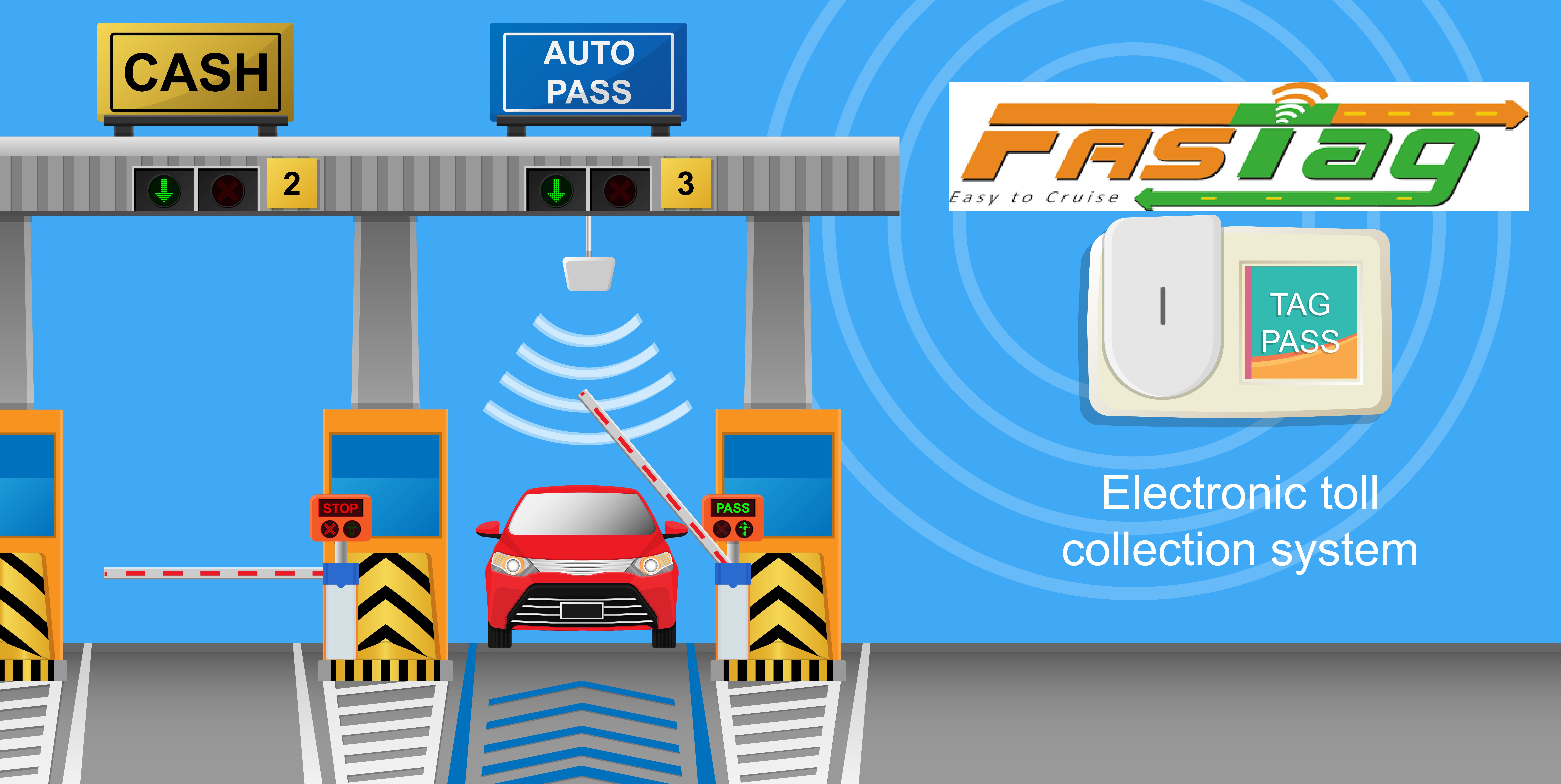General Insurance Blogs, Articles & Updates by - Magma HDI
Have us call you
- RENEW YOUR POLICY
- BUY NEW POLICY

FASTag Uses and Benefits
Do you travel a lot by road? Are you tired of waiting for your turn at toll plazas on the interstate highways or expressways? Do you wish to get done with it as quickly as possible? If yes, then you must get a FASTag! As the name suggests, a FASTag is a tag which is a mean to ensure faster transit across toll plazas. The tag is placed on the windshield of the car and uses Radio Frequency Identification Technology. The tag is scanned by the tag readers placed at toll booths who then deduct the toll amount from the FASTag account. All toll plazas placed along the national highways are now using FASTag for payment of toll as per the guidelines of the government of India.
As the balance in FASTag reduces, the user needs to reload the balance in the linked wallet account or the linked bank account. By eliminating the need for cash payments at toll plazas, FASTag ensures a quicker and smoother flow of traffic.
The following reasons highlight how using a FASTag can help you save time on your journey: -
● Quick payment - As there is a FASTag affixed to your car, you wouldn't have to search your wallet for cash which ultimately reduces the duration of the transaction and your time is saved.
● Less fuel wastag - As you do not need to stop and restart your vehicle, less petrol or diesel is burned, which saves your fuel tank from draining quickly.
● Hassle-free recharge- You can easily recharge your FASTag using various methods like Internet banking, mobile wallet apps, NEFT, RTGS or even your credit and debit cards.
● Message alerts - Every time your FASTag is used, you get an alert SMS on the mobile number registered with the card which ensures the prevention of its misuse.
● Long validity- A FASTag is valid for five years, which means you need not worry about changing it frequently.
● No requirement of cash - The work of cash is taken over by the FASTag. Therefore, it eliminates the necessity of carrying cash for toll payments.
● Online portals- You can check the transactions made using your FASTag whenever you wish using specific web portals meant for the same.
Now, onto some Frequently Asked Questions: -
How to get a FASTag?
To buy a FASTag, you can ask the toll plaza employee for their sales department, or contact authorized agencies or banks that sell them. Many platforms offer car insurance quotes online and sell FASTag as well.
How much does a FASTag cost?
Generally, a FASTag can cost you around two hundred rupees for the purchase, which excludes recharge expenses.
Where is it placed?
FASTags are affixed on the windshield of the car in a very specific manner that allows the scanners placed at the toll plaza to scan it.
How to know if your card has been used?
As stated in the above benefits, a text message is delivered to the registered mobile phone when the FASTag is used. This is a sort of confirmation to the owner that payment has been made.
Do you need to maintain a certain balance?
You don't need to maintain a balance for sure, but yes there is a minimum value for a top-up of the tag which amounts to a hundred rupees.
Where is a FASTag valid?
Throughout the country, a FASTag can be used to make payments at toll plazas regardless of the city or state.
While getting FASTag will help you zoom seamlessly on the highways, do remember to check car insurance quotes online to get protection against possible accidents and incidents while on the road.

Do you experience frequent swelling in your legs? These can be the probable reasons
Medical issues are being observed as a rising problem, mainly because of drastic lifestyle changes, improper nutrition, and irregular physical activities. The best way to tackle medical adversities is by prioritising your health and never neglecting the symptoms that your body throws at you. Most health conditions develop over time due to your habits, while some are even hereditary.
One common issue is swelling in the legs, feet, and ankles. There can be multiple reasons for swelling, including physical injuries, medicinal reactions or allergies, and underlying conditions like cholesterol, diabetes, etc. If you see a frequent swelling pattern in your legs for a month, seek medical help, as it may be something to worry about. Leg swelling happens for two main reasons - edema and inflammation.
Let's explore more about them.
Factors causing edema
Several factors contribute to edema or fluid buildup in one or both legs. Here we discuss some major factors that require immediate medical assistance.
1. Congestive heart failure
When the heart is too weak to pump blood to body parts, this condition is termed congestive heart failure. Such a reduction in blood supply leads to fluid buildup, especially in the legs. Besides swelling, a person may also experience trouble breathing and constant tiredness.
2. Veins
Two vein issues can cause leg swelling and other problems in the body. Those are:
● Clotting in veins: A blood clot can form in any vein in your leg, which can break off and easily travel to your lung. This can lead to a life-threatening situation if left unnoticed. Other than swelling, if you also experience constant leg pain, cramps, or red or blue skin, immediately visit your doctor, as these might be the symptoms of vein clots.
● Chronic venous insufficiency and varicose veins: A person suffers from these conditions when the valves inside the leg veins cannot maintain the blood flow up toward the heart. Instead, the blood gets collected in pools, resulting in varicose veins. Other than swelling, you may also experience achy legs, pain after sitting and standing for too long, and dry, irritated skin.
If you experience these problems, visit the doctor to start your treatment.
3. Reaction from certain medication
Not every medication suits our bodies. Some cause side effects such as swollen legs, hair fall, irregular menstrual cycles, etc. Pain in the legs can also be a symptom of a medicine reaction. Notice the change in your body and talk to the doctor about getting alternative medicines that have zero to minimal side effects.
Factors causing inflammation
Some of the common causes that lead to inflammation in our body are listed below:
1. Arthritis
Anyone can develop arthritis at some point in their life. Due to the constantly changing environment, it is open to older adults. Diseases like gout, knee bursitis, osteoarthritis, and rheumatoid arthritis are becoming more common among people of all ages as they ignore proper care of their bodies, diet, and physical well-being.
2. Sprains and broken bones
Getting broken bones or twisting your ankle also causes swelling. It's our body's natural reaction to the injury as it moves the fluid and white blood cells into the injured area and releases the chemicals that speed up recovery. Some of the common injuries are mentioned below:
● Achilles tendon rupture: It is our body's largest tendon, and it connects the calf muscles to the heel bone. When it tears, you might experience a sharp pain in the back of the ankle and lower leg. The pain is so intense that a person may be unable to walk. ● Cellulitis: It's a severe infection that happens when bacteria get in through the crack in the skin. It is most common in the lower leg and ankles. Other than swelling, a person may experience tenderness, pain, a reddish skin area, blisters, and dimpled skin.
These were a few common reasons for frequent swelling in the legs. Your legs must be in the best shape to ensure pain-free and smooth movement. Give proper rest to your legs, and indulge in 10-15 mins of daily exercise like jogging or brisk walking.
Irrespective of the medical issues, one should always visit the doctor to rule out any worst outcome. Undoubtedly, any treatment can cost you heavily to your pocket. Therefore, getting health insurance from the best health insurance company in India to cover your medical expenses is ideal. Such insurance policies can help you in your time of need.
Click HERE to buy insurance from the best health insurance company in India.
Disclaimer: The information provided above is for illustrative purposes only. To get more details, please refer to policy wordings and prospectus before purchasing a policy.

Expert's guide on preventing fire outbreaks at home
A home is a place of comfort, protection, and security, but a fire breakout can rapidly turn it into dust. Various sources, including electrical failures, kitchen accidents, and malfunctioning appliances, can start fires. A fire breakout can be disastrous, causing significant damage to your property and personal items and possibly resulting in death. As a homeowner, you must take the essential precautions to prevent fires and safeguard the safety of your property and loved ones.
This blog discusses "expert's advice on preventing fire outbreaks at home." We'll review some of the best ways to protect your home from fire threats and the importance of obtaining the best home insurance in India. Following these suggestions and purchasing the appropriate house insurance coverage, you can protect your home from fire damage and enjoy peace of mind. So, without any delay, let's begin!
1. Install smoke alarms
Installing smoke alarms is one of the most effective strategies to avoid home fires. Smoke alarms detect smoke and notify you during a fire. This will help you to take the required precautions to prevent further damage. Install smoke alarms in each room and check and replace the batteries regularly.
2. Be careful of faulty appliances
Faulty appliances are one of the leading causes of home fires. Appliances must be handled with care and inspected regularly for flaws or damage. Always follow the manufacturer's instructions and use the appliances in accordance with their recommendations.
3. Check electrical wiring
Faulty electrical wiring is another major cause of home fires. Inspect your home's electrical wiring regularly for signs of wear and tear. Repair or replace any damaged wiring or electrical components immediately to avoid fire hazards.
4. Cook safely
Cooking mishaps are a significant cause of home fires. Practicing safe cooking skills and using caution when using the stove or oven is critical. Always keep combustible things away from the cooking area, and never leave the kitchen unattended when cooking.
5. Keep flammable objects away
Keeping flammable objects away from heat sources is critical to prevent home fires. Ensure that all flammable materials, such as cleaning solutions, paints, and petrol, are kept securely away from any heat source.
6. Have an emergency plan
Having an emergency plan can go a long way toward preventing home fires. Prepare an exit plan for a fire, and teach your family how to use fire extinguishers.
7. Obtain the best home insurance in India
The best home insurance in India is essential to protect your home from fire damage. A comprehensive house insurance policy covers fires, natural catastrophes, theft, and other unanticipated events. You get compensated for your loss and are relieved from financial stress due to the fire outbreak.
8. Conduct regular inspections
Inspecting your home for fire hazards regularly will assist in discovering potential threats and avoiding fire outbreaks. Periodically inspect your home, particularly the kitchen and electrical wiring, and take the required precautions to prevent fire threats. Install water sprinkler mechanisms, smoke detectors, and fire alarms to ensure safety against fire catastrophes.
Every homeowner is responsible for preventing fires in their homes. A fire breakout can be disastrous, causing significant damage to your life, property, and personal items. By following the expert's advice and taking the required precautions, you can ensure that your home is safe from fire threats and that you live in a secure atmosphere. In addition to these precautions, obtaining the best home insurance in India is necessary. A comprehensive house insurance policy covers fires, natural catastrophes, theft, and other unforeseen events, providing financial security and peace of mind. You can research alternatives and select the best home insurance in India to meet your requirements.
Click HERE to know more about how you can purchase the best home insurance in India and its benefits.
Disclaimer: The information provided above is for illustrative purposes only. To get more details, please refer to policy wordings and prospectus before purchasing a policy.

Here’s when you should change your bike’s engine oil
It is always necessary to change the engine oil timely to improve the performance and sustain the long life of your bike. However, many people ignore the importance of quality engine oil, which severely damages the engine and the bike's overall performance. Therefore, in this post, we'll discuss when you should change your bike's engine oil and why it is required to keep it in ideal condition.
When it is time to change the oil
To know when to change the bike's oil, you have many indicators that you need to keep an eye on. Your bike gives you several alerts indicating issues with the engine due to low oil levels or the need for replacement. You might hear weird sounds when giving ignition or revving your bike. Low oil level or poor quality oil can severely damage the engine and leave you to bear a massive repair and maintenance cost.
Below are some signs that will help you change the oil on time.
1. Read the manual
It might be possible that every bike has a different requirement when dealing with the engine. Read the bike manual to understand the guidelines and specific requirements for your bike. You can also learn about engine type, driving conditions, climate, etc.
2. Oil level
Check the oil level in your bike with the help of a dipstick. If you find the oil below the given level, you should look to change the oil.
3. Oil colour
You'll find a clear orange colour. As time passes and you use the bike regularly, the oil turns black due to impurities, wastes, and remains. When you find the oil dirty and get a foul smell, it is time to change it.
4. Engine performance
When you don't change the oil, you can't expect the desired performance from your bike. It is the case when your bike's oil turns black, and you should change it at the earliest. If left unchanged, you'll keep getting sluggish acceleration, reduced fuel economy, and poor performance.
5. Mileage
Generally, manufacturers suggest a rider to change the oil every 3,000–5,000 km. Changing the oil is always advisable when you cover this distance on your bike.
6. Unusual engine clatters
Untimely oil replacement might increase friction and wear on engine parts, leading to unexpected noises. So, if you hear any noise or clashes, you must change the oil. On the other hand, if you use your bike for high-performance racing, off-road biking, or long trips, you should always look to change the oil timely. These tours can strain your bike's engine and cause its performance to go down.
Points you must be aware of about the oil change
● Synthetic oils perform longer instead of the normal engine oils. You get better mileage and performance from your bike's engine. Also, thoroughly read the user manual to get clarity on oil changing.
● Regularly keep checking the oil level with a dipstick. Look at the colour and density of the oil.
● Visit the local garage and inspect your bike's engine for an oil change.
● Always use the best quality engine oil recommended by the bike manufacturer to avoid harming the engine and its parts.
It is evident to regularly monitor your bike's engine oil to enjoy a smooth riding experience and ensure the engine's longevity. Along with checking the engine oil's quality, you must also look for reliable bike insurance. Accidents can occur at any point. Therefore, you must protect your asset with comprehensive coverage. So, insurance and a timely oil change are two basic requirements that must be fulfilled on time for a stress-free and enjoyable riding experience.
Click HERE to buy reliable bike insurance.
Disclaimer: The information provided above is for illustrative purposes only. To get more details, please refer to policy wordings and prospectus before purchasing a policy.

Why motor insurance is not enough: The importance of fire insurance for your vehicle
When protecting your vehicle, having a motor insurance is a legal requirement in most countries, including India. However, many vehicle owners mistakenly believe that motor insurance is enough to cover all kinds of damages, including those caused by fire. Unfortunately, this is not the case. Fire accidents can cause significant damage to your vehicle, leaving you with a hefty repair bill. This is where fire insurance comes to your protection. Fire insurance is a type of insurance that covers damages caused by fire, including damages to your vehicle.
This blog will discuss the types of damages fire insurance covers, the cost of fire insurance, and how to obtain fire insurance for your vehicle.
1. Motor insurance does not cover fire damage
While motor insurance covers damages caused by accidents, theft, and natural calamities, it does not cover damage caused by fire. If your vehicle catches fire, you cannot claim any compensation from your motor insurance policy. On the other hand, fire insurance is specifically designed to cover damages caused by fire.
2. Fire accidents are common in India
India witnesses a high number of accidental and intentional incidences of fire annually. Fire can spread quickly and cause significant damage to your vehicle in minutes. Having fire insurance for your vehicle will protect you against the financial impact of such accidents.
3. Fire insurance covers the cost of repair or replacement
If your vehicle is damaged by fire, fire insurance will cover the cost of repair or replacement, depending on the extent of the damage. This means you will not have to bear the entire cost of repairing or replacing your vehicle's parts, which can be a significant financial burden.
4. Fire insurance is affordable
Contrary to popular belief, fire insurance is not expensive. The cost of fire insurance for your vehicle will depend on various factors, such as the age, make, and model of your vehicle, as well as the extent of coverage you choose. However, fire insurance is a small price compared to the potential cost of repairing or replacing your vehicle after a fire accident.
5. Fire insurance provides peace of mind
Having fire insurance for your vehicle provides peace of mind, knowing you are protected against the financial impact of fire accidents. This is especially important if you rely on your vehicle for your livelihood or have invested significant money in purchasing or modifying your vehicle.
6. Fire insurance covers damages caused by riots
In a situation of riots and civil disturbances, vehicles are often targeted and damaged by fire. Fire insurance covers damages caused by such incidents, providing financial protection to your vehicle.
7. Fire insurance covers damages caused by electrical faults
Electrical faults can also cause fire accidents in vehicles. Fire insurance covers damages caused by electrical faults, providing financial protection against such incidents.
8. Fire insurance is easy to obtain
Obtaining fire insurance for your vehicle is easy and uncomplicated. You can purchase fire insurance as an add-on to your motor insurance policy or as a standalone policy from any insurance provider. Purchasing it is quick and hassle-free, and you can do it online from the comfort of your home.
While motor insurance is mandatory by law in India, more is needed to protect your vehicle against all kinds of risks. Fire accidents can cause significant damage to your vehicle, leaving you with a hefty repair bill. This is why it's essential to have fire insurance for your vehicle in addition to your motor insurance India. Fire insurance provides comprehensive financial protection against damages caused by fire, riots, electrical faults, and other such incidents.
Click HERE to learn more about motor insurance India and its benefits.
Disclaimer: The information provided above is for illustrative purposes only. To get more details, please refer to policy wordings and prospectus before purchasing a policy.

Here are the different types of back pain you must be aware of
Back pain is one of the most common problems everyone faces across the length and breadth of the country. Some people may face a dull pain in their back now and then, while for some, it may be constant. Others may experience sudden and excruciating pain in their back, that they may be unable to sit or walk properly.
The leading causes of back pain are a fall, an accident, lifting a heavy load, or age-related factors. Sometimes a medical condition can also result in back pain. The treatment varies with the category of back pain you are suffering from. Hence, let us first understand the different types of back pain.
1. Cervical pain
The cervical region in our body is the vertebrae of the neck. When you suffer from pain in or around your spine, it is a case of cervical pain beneath your head. It is a common type of pain that can last a few days to several years. The common causes of cervical pain include poor and slumped posture, physical strain, mental stress, herniated disc, tumors, and other health conditions.
In Cervical pain, you may feel the most axial neck pain in your neck or radicular neck pain that shoots to other body parts, such as your shoulders or arms. Cervical pain is not very serious and can be treated with treatments such as exercise, stress management, and medicines for pain.
2. Thoracic back pain
Thoracic back pain is the pain in your upper back. The main symptoms include fever, loss of weight, nerve pain or numbness in the legs or lower body, physical trauma, noticeable deformity, severe stiffness, and constant severe pain that does not go away even after a change in sleeping or sitting position.
Thoracic back pain should not be ignored because the upper portion of the spine is connected to the ribs that protect your heart and lungs. You should immediately see a doctor if you experience any of the above symptoms for a long time.
3. Middle back pain
Middle back pain occurs below your rib cage but above the lumbar spine region. You may feel similar symptoms, such as fever, chills, weight loss, dizziness, etc., as in thoracic back pain. However, sometimes the symptoms can be vague, and you cannot easily diagnose them.
Middle back pain is caused due to several reasons, such as obesity, stress, anxiety, lack of physical activity, smoking, and pregnancy.
4. Lower back pain
Lower back or lumbar pain is common in people over 30 years of age. It is caused by a strain on muscles or tendons in the back. Arthritis of the spine is also a common cause of lower back pain. The pain can be mild to severe, leaving people unable to walk, sleep, work, and do their daily activities properly.
The common causes of lumbar pain are obesity, back injuries and accidents, lifestyle, mental health, diseases, and age. Such pain can come and go suddenly, especially after you bend abruptly to pick up something or during a sport. Medications and physical therapy can treat it, while sometimes surgery may also be required to cure it.
Back pain is becoming common even among youngsters, making it a cause of concern. Excessive junk food intake causing obesity, a lifestyle with no physical activity, stress and anxiety, smoking, etc., are primarily causing back pain in the younger generation.
Furthermore, this problem is alleviated with age, injuries, and accidents. A good health insurance policy can be very helpful in case you require a long treatment or surgery due to prolonged back pain problems. It will make you financially secure and stress-free, even if your treatment lasts for several years.
Click HERE to buy the best health insurance in India.
Disclaimer: The information provided above is for illustrative purposes only. To get more details, please refer to policy wordings and prospectus before purchasing a policy.

Do you see black or white smoke from your motorcycle's muffler? These can be the reasons
When you notice black or white smoke coming out of your motorcycle's muffler, it is a sign that something is not working correctly. The smoke's colour makes it possible to tell what kind of problem the engine faces. White smoke typically indicates the presence of coolant or water mixing with the fuel in the combustion chamber. Whereas black smoke typically indicates a vibrant air/fuel ratio. The causes of black or white smoke can vary.
The following are some common causes of black or white smoke coming from a motorcycle's muffler:
Black smoke
1. Fuel injectors
The ability of the fuel injectors to supply the engine with the appropriate amount of fuel may be compromised if they are clogged or broken. Black smoke can result from incomplete combustion caused by a shortage of fuel.
2. Spark plugs
Black smoke is produced when the air/fuel mixture does not burn completely due to a damaged spark plug.
3. Inappropriate fuel blend
Black smoke can result from incomplete combustion, caused when the fuel combination is vibrant or too much fuel in the air/fuel mixture. This may occur if the motorcycle uses power with a more excellent octane rating than the engine needs.
4. Air filter
Black smoke may result from the engine receiving less air than required due to a blocked or dirty air filter. A vibrant air/fuel mixture caused by a dirty air filter can result in incomplete combustion.
5. Carburetor
Black smoke can also be produced by a vibrant air/fuel mixture from a dirty or faulty carburetor.
6. Exhaust system
Black smoke can result from an accumulation of exhaust gases brought on by a damaged or blocked exhaust system.
7. Carbon accumulation
An engine's combustion chamber, valves, and pistons may accumulate carbon deposits over time. These carbon deposits can interfere with combustion and lead to black smoke.
8. Oxygen sensor malfunction
The oxygen sensor determines how much oxygen is in the exhaust gases. The oxygen sensor may be unable to provide the engine control module with reliable readings if it is broken or faulty. This can cause the engine to receive insufficient fuel, leading to black smoke.
White smoke
1. Overheating
If the engine operates excessively, the coolant may boil and combine with the fuel in the combustion chamber. Additionally, this may cause the silencer to release white smoke.
2. Incorrect fuel blend
White smoke may result from an excessively lean fuel combination or an air/fuel mixture that contains too much air. This might occur if the motorcycle is powered by fuel that doesn't meet the engine's octane requirements.
3. Transmission fluid
A motorcycle with an automated transmission may emit white smoke from the silencer if the transmission fluid is burning.
4. Defective fuel injectors
The engine may not receive the proper amount of fuel if the fuel injectors are not operating correctly. White smoke can result from incomplete combustion caused by a lack of power.
5. Coolant leak
Coolant can leak into the combustion chamber if the engine's head gasket is damaged or the cylinder head is cracked. White smoke will flow out of the muffler when the engine runs because coolant and fuel will combine.
6. Water in the fuel
White smoke may emerge from the silencer if the fuel contains water. This may occur if water has collected in the motorcycle's fuel tank due to prolonged sitting.
7. Defective glow plug
The glow plug heats the combustion chamber, which helps the engine start. White smoke may result from incomplete combustion caused by an inaccurate glow plug.
A motorcycle's muffler may emit black or white smoke, indicating several engine issues. It is essential to determine the root of the problem and take quick action to fix it to stop the engine from suffering additional damage. Taking your motorbike to an expert mechanic for diagnostic and repair is advised if unsure of the cause. Motor insurance provides financial security in the case of an accident or damage to your vehicle. It is advisable to buy motor insurance online as it eliminates the need for paperwork and mediators, which may result in cost savings on insurance premiums.
Click HERE to buy motor insurance online.
Disclaimer: The information provided above is for illustrative purposes only. To get more details, please refer to policy wordings and prospectus before purchasing a policy.

Let's have a look at some common motorcycle injuries that you must know
Motorcycles are open vehicles with no outer enclosures to protect you in case of a fall or an accident. Also, they are smaller than cars, making them less prominent and visible on the roads. This makes motorcycle riders more susceptible to accidents that can cause injuries, many times so severe that they can result in the loss of lives of the rider and the pillion.
Motorcycles are also lighter in weight, meaning they may drag on the road for a few metres after a fall or crash. This may also cause severe injury to the passengers. Let's look at some common motorcycle injuries you must know.
1. Rashes
Rashes are the most common injury that motorcycles can cause. When you fall from your bike, your arms and legs are most susceptible to rubbing against the ground's surface. This causes rashes on your skin, the severity of which depends upon the intensity of the drag or fall. If you were riding your motorcycle at high speed, you would likely develop severe rashes and bleeding, which will take a few days to heal. You can even develop infections and nerve damage.
2. Fracture
A fracture or multiple broken bones are also a common motorcycle injury. The impact of your fall on the ground can be intense enough to break or crack a few bones in your body. A fracture commonly occurs in the legs, forearms, or pelvis bones. A severe accident can even cause damage to your skull and rib cage.
3. Head injuries
The impact area of your fall from the motorcycle is often your head and neck. You may face severe head injuries, especially if you are not wearing a helmet. Youngsters tend to drive their motorcycles fast and recklessly, and falling at such high speeds can be fatal to the head and life.
4. Spinal and neck injuries
Your neck and the spinal cord may face irreparable damage if the main impact area is the neck or back. Such damage can be intense and extremely painful. The pain can be chronic, and the accident can result in paralysis, nerve damage, and even death.
5. Hands, arms, and legs
After a fall due to a motorcycle accident, you instinctively throw out your arms and land on them. Your hands and arms immediately bear the brunt of the fall, and you may suffer deep rashes, cuts, and broken bones. Such accidents can also result in nerve damage and paralysis of your arm.
Similarly, the main impact area of a motorcycle accident is your legs. In most accidents, you will hurt your legs by suffering rashes, deep cuts, or a fracture.
6. Muscle tear
A motorcycle accident often does not break your bones or cause a fracture. Instead, it causes muscle tears, soreness, and internal muscle damage. Since the impact is internal, recovery also takes a lot of time.
7. Burns
Severe burns are also a possibility when you meet with a motorcycle accident. This rarely occurs when the fall or accident is intense enough to spill the fuel from the fuel tank during the crash. The motorcycle may immediately catch fire, causing severe burns. Burns cause intense pain and take a long time to heal.
A motorcycle accident can happen unannounced with anyone, anytime and anywhere. You should always wear protective bike gear while riding your motorcycle, such as a protective jacket, knee and arm pads, gloves, etc. A helmet is a must and should be worn every time you ride your motorcycle. You should also choose a good motor insurance company in India to protect your vehicle from damages due to an accident. It will protect you financially and cover all the repair costs when your bike needs repair work.
Click HERE to buy insurance from the best motor insurance company in India.
Disclaimer: The information provided above is for illustrative purposes only. To get more details, please refer to policy wordings and prospectus before purchasing a policy.


